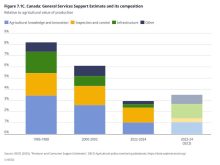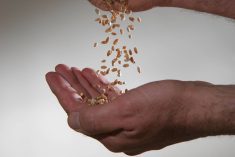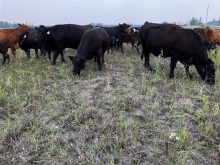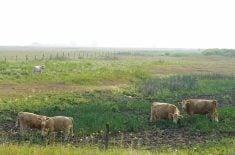Details of the new five-year agricultural funding agreement Manitoba signed with the federal government are beginning to emerge.
The Sustainable Canadian Agricultural Partnership (SCAP) was announced by Manitoba Agriculture Minister Derek Johnson and federal Agriculture and Agri-Food Canada Minister Marie-Claude Bibeau on April 6.
The broad strokes have been known since last summer, when provincial, federal and territorial ag ministers announced they had reached an agreement-in-principle on the new deal, worth $3.5 billion nation-wide. The agreement replaces the previous Canadian Agricultural Partnership that expired March 31.
Read Also

Journal pulls long-cited glyphosate study for ethics violations
The journal Regulatory Toxicology and Pharmacology has retracted a 2000 Monsanto-linked glyphosate review, drawing new scrutiny as Bayer faces mounting legal pressure.
Manitoba’s slice of the deal includes $221 million for strategic agricultural initiatives, a $45-million increase compared to the previous agreement.
Why it matters: The new agreement will underpin public funding allocations for agriculture for the next five years.
Several big-ticket items on the national scale, all announced last summer, include a 25 per cent (or $500 million) increase in funding, as well as a commitment to improve business risk management programs. That included a promise to raise the AgriStability compensation rate to 80 per cent from 70.
Half of the funding increase is earmarked for the Resilient Agricultural Landscape Program (RALP). It is designed to support ecological goods and services provided by the agriculture sector and plays roughly the same role as the Ag Action Manitoba Program under the previous agreement. It funds on-farm projects that remove carbon (or carbon dioxide) from the atmosphere to reduce greenhouse gas emissions.
Manitoba
Johnson said details specific to Manitoba will be revealed in coming weeks.
“We’re going to increase sector revenue and exports and increase the participation of Indigenous people, women and youth in agriculture and the agri-food industry,” he said.
Johnson said the government is still working out specific program details, but he outlined main focus areas that include research and innovation; market development and trade; climate change and the environment; building sector capacity, growth and competitiveness; and resiliency and public trust.
He said funding under the umbrella of science, research and innovation would target basic and applied research to ensure the industry remains competitive.
“It’s important that we capture any emerging opportunities,” he said. “We’re about science-based solutions rather than ideology.”
Under market development and trade, Johnson said programs would help grow Manitoba’s agri-food sector, maintain existing markets and capture emerging opportunities. Programs will target interprovincial trade, export capacity, access market development and research and product commercialization.
He pointed to the Roquette pea processing plant near Portage la Prairie as an example of market development work that needs to continue. When large companies like Roquette show interest in doing business in the province, it can’t let opportunities slip away.
“We have the environment in Manitoba to continue to attract these large producers with our green footprint,” he said, citing the province’s readily available hydro power as one example.
Program funding under sector capacity, growth and competitiveness will focus on farm modernization, expansion and building a skilled workforce.
Public trust is also a funding area that Johnson highlighted as “so underrated in Canada.”
“Everybody that goes to a grocery store in Canada can trust anything that they pull off the shelves; they’re not afraid to feed it to their children or grandchildren,” he said. “We have to ensure that we maintain that public trust and build on it.”
Going green
With the deliberate addition of “sustainable” to the agreement’s title, environment takes a front seat in terms of programming. Programs have stated aims to increase the environmental and economic stability of the sector, with a focus on climate change adaptation and air and water quality. With its focus on soil health, RALP also falls under this category.
“We will continue to focus on increasing the environmental resilience of the agricultural landscape by increasing the adoption of on-farm land use and management practices,” Johnson said.
The hope is that government incentives will encourage early adopters to shine a spotlight on positive outcomes from adopting these practices, according to the provincial ag minister.
“Our goal is to just use the money to educate producers that are interested in moving forward with it.”
The first program launched under RALP will focus on watershed resilience and will be available to farmers, community pastures, First Nations communities and agricultural Crown land forage leaseholders. Johnson said the addition of crown lands was a definite win for Manitoba.
“It’s something that we successfully got added in this five-year agreement. The previous CAP did not have it as agriculture crown lands, so that was a huge step forward.”
Industry reaction
With limited information available so far, KAP president Jill Verwey said she’s happy with the way things have progressed, especially with the funding increase and expansion of AgriStability. She’s cautiously optimistic about what’s coming.
“We’re looking forward to further descriptions of what specific programming is going to be available through the Manitoba Department of Agriculture, once those particular programs are finalized,” she said.
Carson Callum, general manager of Manitoba Beef Producers, is also taking a wait-and-see approach.
“I think, in principle, the agreement shows some areas that could be directly supportive of the cattle sector here in Manitoba,” said Callum, noting RALP is particularly interesting to his sector.
“There could be a direct benefit to the cattle sector when you think about all of the ecosystem goods and services that cattle do provide on the land.”
Nevertheless, Callum is reserving judgment until he sees more.
“Those details and eligibility criteria are not available, so we look forward to being able to review those once they are posted.”
According to Johnson, producer groups won’t have long to wait. The minister teased “a few substantial announcements” in the near future.
“We’ve started rolling the programs out, and they will continue through the spring, summer and into the fall so we can align with the industry’s needs,” he said.
















